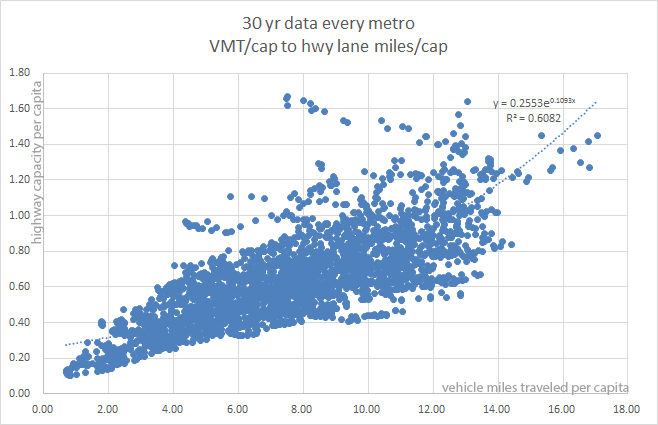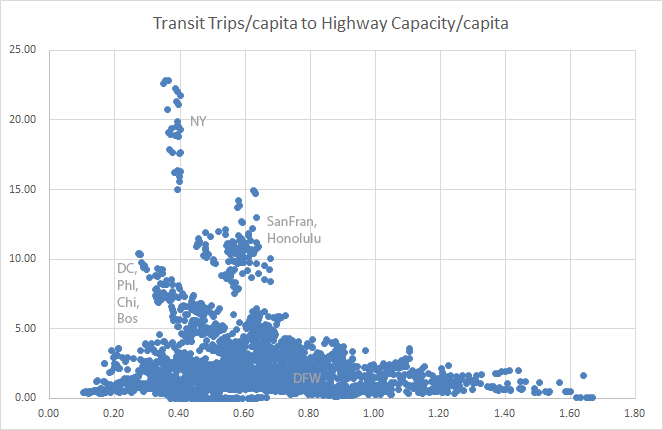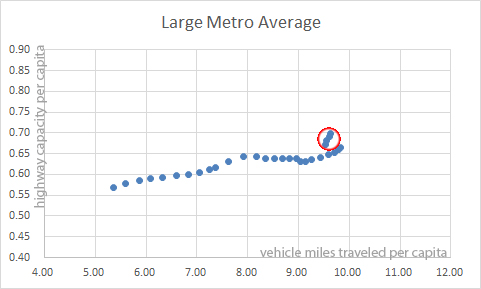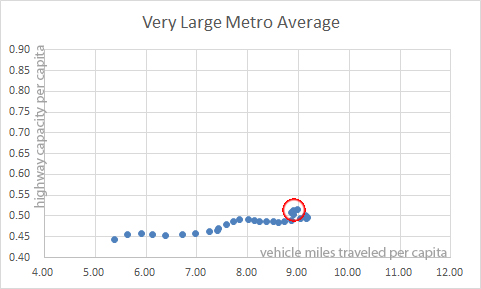In a previous post, I showed how Texas how increased highway capacity only served to make for more driving; that demographic shifts over the past few years had begun to change behavior away from car-dependence, and that we continue to add highway capacity despite this demographic preference away from the car. Furthermore, despite claims of increased overall congestion costs, that big number is simply a factor of factoring congestion costs per capita and then adding all of those individual numbers together. The reality is that due to the lessened driving, congestion costs per capita are dropping simply because people are driving less.
Now I want to back out a bit more to find a few more narratives out of the immense amount of incredibly disorganized data compiled by TTI.
Here are three thousand data points. This is 500 metropolitan areas charting all thirty years between 1982-2011 for all of them illustrating the relationship between highway capacity per capita to vehicle miles traveled per capita.

The more highways you build, the more people end up driving. The reason is two-fold and it has to do with connectivity (or lack thereof) and the shift instilled into the real estate market. Infrastructure is the control knob of demand. It decides where and how much demand there will be in relation to the acreage. The market then responds with supply. Sometimes it is right, sometimes it is wrong, but over time (typically a generation) it eventually finds its level.
We see this play out along highways in different contexts. Where highways were imposed on existing urbanized areas it exerts a downward pressure on the real estate market. Where highways are introduced in greenfield areas, there is an upward pressure because an area once inaccessible is now accessible to some degree. The problem lies when both are introduced (intra-city and inter-city). This creates cannibalization where we are simply spending billions on both projects to shift the real estate market from one place to another and we call it growth.
When a highway is first introduced into an existing urbanized neighborhood it disconnects and fragments existing socio-economic bonds. Physically, by its very nature as a limited-access facility, it severs the grid and makes the simple process of crossing what used to be a street now impossible. The inherent disconnection then devalues. Density can no longer exist because it is a function of proximity, now lost.
Then, over time the market elongates along the highways. Destinations stretch out and because they are along the highways it makes the highways seemingly the most convenient way to get about. Except, it is the most convenient way for everyone else as well, but only in optimal conditions…when no one else is on the road. This is the fundamental flaw of highways in cities: you can thank the Braess Paradox. Cities flourish with lots of short trips. Cities become congested by the very effort to decongest them with the highways as highways 1) put everyone in cars (you aren’t going to cross it on foot), and 2) funnel all traffic towards them because of their limited-access nature disconnecting the grid and limiting route choice (amplified by the real estate market adapting to it).
On the flip side is transit usage. Below is transit trips per capita in relation to highway lane miles per capita. The more highways you build in metropolitan areas, the less convenient transit becomes. Both are very expensive, only Dubai levels of cash on hand can afford to spend so frivolously to build both, but the real problem as mentioned above is that highways in cities devalue land while transit inflates it. Meaning, one can afford the infrastructure through the tax base, the other cannot. However, transit can’t overcome an overbuilt highway network. And thus, as you can see in the lower middle blob of blue is DFW’s transit ridership amongst metro areas that don’t even have rail systems.

The interesting if irrelevant phenomenon above is how cities tend to cluster in groups.
In the post from the other day, I mentioned how driving had begun to wane recently primarily through a shift in demographic preference. Kids who had grown up dependent upon parents or bus drivers to chauffeur them around, who found freedom on two pedaled wheels, were rejecting the world around them. The below charts takes the metro averages by grouped population and it reveals some patterns.
Notice the cluster of a three to five data points highlighted in red. It occurs in every sized metro. What is happening there is a sudden jump in overall capacity coinciding with a drop in driving. While we already know that the drop in overall driving seems to be due to a shift in preference, that doesn’t explain the corresponding jump in capacity. Those jumps in capacity are all between 2008-2011: the shovel-ready projects of the stimulus. Only problem, what was shovel ready wasn’t needed. It just happened to be what was ready to be built and shelved for a while during the recession despite being the opposite of what we should have been spending on, the future rather than the past.







